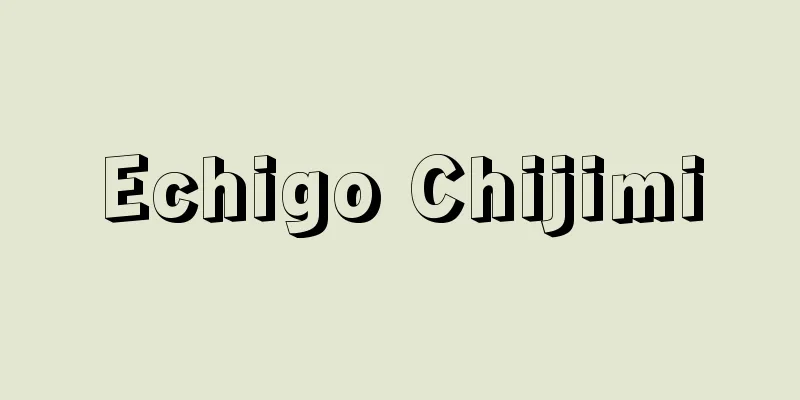Echigo Chijimi

|
A high-quality linen fabric with wrinkled yarn dyed that was woven in the Uonuma district of Echigo Province. Linen fabric from this region has long been known as Echigofu, but it is said that in the early Edo period, around the Kanbun era (1661-1673), Akashi ronin Horijiro Masatoshi, who moved to the outskirts of Ojiya, succeeded in weaving chijimi by strongly twisting the weft threads of plain-woven linen fabric. With the rise in demand due to the development of the monetary and commodity economy, high-quality aoso was imported from Yonezawa and Aizu, and production rapidly increased during the Genroku era (1688-1704). Chijimi became popular nationwide as a high-quality summer garment, with annual production reaching 200,000 bolts during the Tenmei era (1781-1789). The three crepe markets of Ojiya, Tokamachi, and Horinouchi were bustling with merchants from all over the country, and distribution routes expanded with traveling crepe merchants travelling to Edo and crepe wholesalers establishing sales bases in Edo and Kyoto. Although it was temporarily hit hard by the ban on luxury goods during the Tenpo Reforms, production remained at around 100,000 bolts until the end of the Edo period. The indigo cloth purchased from indigo merchants was woven on a stationary loom after being rolled. There was no system of hiring machines, and crepe weaving remained within the realm of rural cottage industry. The traditional techniques were passed down to Ojiya crepe and wrinkle-free Echigo Jofu, both of which are designated as Important Intangible Cultural Properties by the national government and UNESCO Intangible Cultural Heritage. [Koichi Sugimoto] "The History of Ojiya City, Volume 1" (1969, Ojiya City) ▽ "The History of Tokamachi City, General History, Volume 2" (1995, Tokamachi City) ▽ "The Production of Echigo Chijimi and the Local Community, by Koichi Sugimoto" (Edited by Shoji Kobayashi, included in Volume 5, Early Modern Period, Volume 2, edited by Naofumi Hara and Koji Ohashi, Japan Maritime History Series, 2006, Seibundo Publishing) Source: Shogakukan Encyclopedia Nipponica About Encyclopedia Nipponica Information | Legend |
|
越後国魚沼郡一帯で織られていた皺(しぼ)のある先染めの高級麻織物。この地方の麻織物は越後布(えちごふ)の名で古くから知られてきたが、江戸前期、寛文(1661~1673)の頃小千谷(おぢや)近郊に移住した明石の浪人堀次郎将俊(ほりじろうまさとし)が平織の麻布の緯糸(よこいと)に強い撚(よ)りをかけて縮の製織に成功と伝える。貨幣・商品経済発展による需要の高まりを背景に、米沢や会津から良質の青苧(あおそ)を移入して元禄年間(1688~1704)急激に生産を伸ばした。縮は夏の高級衣料として、天明年間(1781~1789)には年産20万反に達したといわれ、全国的に普及した。小千谷、十日町(とおかまち)、堀之内(ほりのうち)の縮3市場は全国各地からの商人で賑わい、また縮行商人が江戸に出向いたり、縮問屋が江戸や京都に販売拠点を持つなど流通ルートも広がった。天保改革の奢侈禁止令などで一時打撃を受けたが、幕末までほぼ10万反前後の生産を維持した。青苧商人から買い入れた青苧は、苧績(おう)みののち、居坐機(いざりばた)にかけて織る。賃機制度は見られず縮織りは農村家内工業の範疇を出なかった。伝統の技術は小千谷縮と皺のない越後上布(じょうふ)に受け継がれ、国指定重要無形文化財・ユネスコ世界無形文化遺産。 [杉本耕一] 『『小千谷市史 上巻』(1969・小千谷市)』▽『『十日町市史 通史編2』(1995・十日町市)』▽『杉本耕一著「越後縮の生産と地域社会」(小林昌二監修、原直史・大橋康二編『日本海域歴史大系 第5巻 近世篇2』所収・2006・清文堂出版)』 出典 小学館 日本大百科全書(ニッポニカ)日本大百科全書(ニッポニカ)について 情報 | 凡例 |
>>: Uesugi family, the guardian of Echigo
Recommend
"Fishing Village Night Tales" - Gyoson Yawa
…He invented observation equipment such as the Ki...
Kanchu - Kanchu
A politician from the state of Qi during the Spri...
Pollution Prevention Business Cost Burden Law
This law was enacted in 1970 to determine the sco...
Oe Asatsuna - Oe Asatsuna
A man of letters in the mid-Heian period. Grandso...
Childe Harold's Pilgrimage - Childe Harold's Pilgrimage
A narrative poem by the English poet Byron. 4 volu...
Numerology
It is a form of divination using numbers, also kno...
Idocrees - Idocrees
…It was first discovered in the ejecta of Mt. Ves...
Iokastē (English spelling) Iokaste
In Greek legend, the daughter of King Oedipus of ...
Diplomatic etiquette
…These official documents related to diplomacy in...
Johann Geiler
1445‐1510 German preacher. Raised in Kaisersberg i...
Concentric circle diagram - Concentric circle diagram
Please see the Nomograph page. Source: Encyclopae...
Ekman, F.
…Swedish physical oceanographer. Born in Stockhol...
Emptiness (Buddhism) - Kuu
...Because this perishes, that perishes." In...
Trieste - Torieste (English spelling)
The capital of the Friuli-Venezia Giulia region i...
Opium alkaloid scopolamine injection - opium alkaloid scopolamine injection
...Side effects vary widely from person to person...





![Sanriku [town] - Sanriku](/upload/images/67cbb7969e84e.webp)



